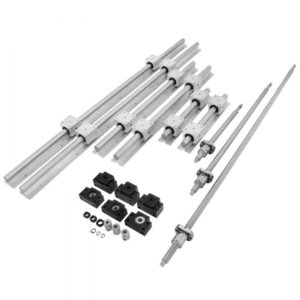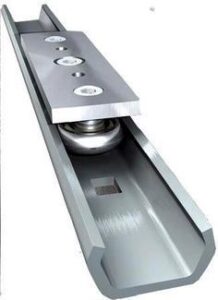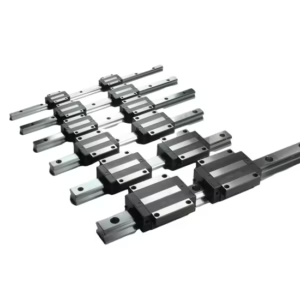Outline for Linear Bearings and Rails Article
| Main Topic | Subtopics |
|---|---|
| Introduction to Linear Bearings and Rails | Definition, Importance in engineering, Historical evolution |
| What are Linear Bearings and Rails? | Basic explanation, Core function, Role in precision engineering |
| Types of Linear Bearings | Ball bearings, Roller bearings, Plain bearings |
| Types of Linear Rails | Profiled rails, Round rails, Flat rails |
| How Linear Bearings and Rails Work | Mechanism, Load distribution, Motion control |
| Applications in Automation | Robotics, CNC machines, 3D printers |
| Industrial Applications | Packaging, Assembly lines, Logistics systems |
| Medical and Scientific Applications | Imaging equipment, Laboratory automation |
| Material Choices for Linear Bearings and Rails | Steel, Aluminum, Ceramics, Polymers |
| Design Considerations | Load capacity, Speed, Precision requirements |
| Advantages of Linear Bearings and Rails | Precision, Durability, Low friction, High efficiency |
| Disadvantages of Linear Bearings and Rails | Cost, Maintenance needs, Sensitivity to contamination |
| Installation of Linear Bearings and Rails | Mounting methods, Alignment, Safety checks |
| Maintenance of Linear Bearings and Rails | Lubrication, Cleaning, Common failures |
| Comparison with Guide Rails | Differences, Similarities, Use cases |
| Innovations in Linear Bearings and Rails | Smart sensors, Self-lubricating systems, Eco-friendly materials |
| Linear Bearings in Transportation | Railway applications, Electric vehicles |
| Linear Rails in Architecture | Elevators, Sliding doors, Automated storage |
| Cost Factors | Material costs, Installation, Long-term value |
| Safety Standards and Certifications | ISO standards, Industry-specific regulations |
| Future of Linear Bearings and Rails | AI integration, Nanotechnology, Robotics growth |
| Case Studies | CNC machines, Robotics, Aerospace systems |
| Linear Bearings and Rails | Complete overview and key insights |
| FAQs | At least 6 common questions with answers |
| Conclusion | Final thoughts, Importance, Future impact |
Introduction to Linear Bearings and Rails
If you’ve ever marveled at the flawless precision of a CNC machine, a robotic arm, or even a medical scanner, chances are linear bearings and rails were at work behind the scenes. These components are the unsung heroes of modern engineering, enabling machines to move with accuracy, speed, and stability.
From industrial robots assembling electronics to laboratory equipment performing micro-level tests, linear bearings and rails keep things running smoothly. Their evolution reflects the growing demand for precision in manufacturing, automation, and research.
This guide explores what they are, how they work, their types, applications, and future innovations shaping the engineering world.
What are Linear Bearings and Rails?
Linear bearings and rails form a motion system designed to provide smooth, controlled, and precise linear movement.
Linear bearings are components that reduce friction between moving parts.
Linear rails are rigid tracks that guide the movement of bearings along a fixed path.
Together, they ensure machines achieve accuracy with minimal wear and tear. They are critical in industries where microns matter, from semiconductor production to surgical robots.
Types of Linear Bearings
Linear bearings come in several variations, each with unique advantages.
Ball bearings: Use small steel balls to reduce friction, ideal for high precision.
Roller bearings: Utilize cylindrical rollers, offering higher load capacity.
Plain bearings (bushings): Simple designs with no rolling elements, suitable for heavy loads and low-cost systems.
The choice depends on speed, load, and environmental conditions.
Types of Linear Rails
Just as bearings differ, so do rails.
Profiled rails: Rectangular, rigid, and ideal for high-precision tasks.
Round rails: Easier to install and more forgiving with misalignment.
Flat rails: Common in compact machinery with limited space.
Each type balances strength, precision, and cost differently.
How Linear Bearings and Rails Work
The principle is straightforward yet powerful.
Bearings ride along the rails, reducing friction.
Rolling elements like balls or rollers distribute loads evenly.
The system ensures repeatable, smooth motion across applications.
Without them, modern automation would grind—literally—to a halt.
Applications in Automation
Automation thrives on linear motion systems.
Robotics: Arms and grippers move precisely using linear rails.
CNC machines: Achieve high precision in cutting and drilling.
3D printers: Depend on rails for layer accuracy.
In every case, reliability and speed are directly tied to the quality of bearings and rails.
Industrial Applications
In factories, linear rails and bearings are everywhere:
Packaging lines: Smooth product transfer.
Assembly stations: Accurate component placement.
Logistics systems: Guiding automated shuttles and carriers.
They boost efficiency while reducing downtime.
Medical and Scientific Applications
The medical field also relies on precision.
MRI machines and scanners: Rails enable smooth patient bed movement.
Laboratory automation: Accurate pipetting and sample handling.
Surgical robots: Depend on rails for flawless micro-motions.
Here, reliability isn’t just about efficiency—it’s about saving lives.
Material Choices for Linear Bearings and Rails
Material selection determines performance.
Hardened steel: Strong and durable, common in heavy-duty systems.
Aluminum: Lightweight and corrosion-resistant.
Ceramics: High temperature resistance, often used in medical and aerospace.
Polymers: Self-lubricating and low maintenance, ideal for cleanrooms.
The right material depends on application demands.
Design Considerations
Engineers must evaluate multiple factors:
Load capacity (static and dynamic).
Speed and acceleration requirements.
Precision tolerance.
Environmental conditions (dust, heat, vibration).
A mismatch can lead to system failure or costly inefficiency.
Advantages of Linear Bearings and Rails
High precision: Consistent accuracy across thousands of cycles.
Durability: Long service life under heavy loads.
Low friction: Reduced energy use and wear.
Efficiency: Faster production with minimal errors.
These strengths explain why they dominate advanced industries.
Disadvantages of Linear Bearings and Rails
However, they aren’t perfect:
High cost: Especially in precision systems.
Maintenance needs: Regular lubrication and cleaning.
Contamination sensitivity: Dust or debris can reduce efficiency.
Still, with proper care, their benefits far outweigh drawbacks.
Installation of Linear Bearings and Rails
Successful installation requires care.
Rails must be mounted on flat, stable surfaces.
Alignment is critical—small errors lead to wear.
Bearings should be pre-lubricated.
Safety checks ensure smooth movement.
Correct installation extends lifespan and boosts performance.
Maintenance of Linear Bearings and Rails
Like any mechanical system, maintenance is key.
Lubrication: Reduces friction and prevents rust.
Cleaning: Keeps dust and debris away.
Inspection: Identifies wear before failure.
Replacement: Bearings may need periodic swapping in high-use systems.
Ignoring maintenance risks expensive downtime.
Comparison with Guide Rails
Although similar, guide rails and linear rails differ.
Guide rails: Direct and contain movement, often for safety (roads, elevators).
Linear rails: Provide precision in controlled environments (machines, robotics).
Both are critical in different contexts.
Innovations in Linear Bearings and Rails
The future is smart and sustainable.
Sensor integration: Detects wear and misalignment.
Self-lubricating materials: Reduce maintenance.
Eco-friendly composites: Lighter and greener.
These improvements promise better performance with lower costs.
Linear Bearings in Transportation
Beyond factories, they support mobility.
Railway carriages: Linear motion ensures door precision.
Electric vehicles: Guide battery modules during assembly.
Aircraft systems: Used in seating and cargo automation.
Transportation increasingly depends on linear technology.
Linear Rails in Architecture
Buildings benefit too.
Elevators: Rails guide cabins safely.
Sliding doors: Smooth opening and closing.
Automated storage systems: Efficient use of vertical space.
Here, rails combine safety with convenience.
Cost Factors
Costs vary widely.
Material type: Steel is pricier than aluminum or polymers.
Precision level: High tolerance systems cost more.
Installation complexity: Affects labor costs.
Though costly upfront, they save money by reducing errors and downtime.
Safety Standards and Certifications
Standards ensure quality and safety.
ISO 9001 & ISO 4921: Global quality benchmarks.
DIN standards (Germany): Widely used in precision systems.
Industry-specific certifications: Medical and aerospace require extra approvals.
Compliance ensures reliability across industries.
Future of Linear Bearings and Rails
The future is bright and innovative.
AI integration: Predictive maintenance and performance monitoring.
Nanotechnology: Ultra-smooth surfaces for zero friction.
Robotics growth: Expanding demand in every sector.
Expect smarter, smaller, and greener linear motion systems.
Case Studies
CNC factories in Japan: Increased accuracy by 20% using upgraded rails.
Robotics in Germany: Automated systems reduced downtime by 35%.
Aerospace in the US: Linear bearings enhanced reliability in satellite assembly.
Real-world cases prove their indispensable role.
Linear Bearings and Rails
Linear bearings and rails are more than machine parts—they are the backbone of precision, automation, and efficiency. From industrial robots to hospital equipment, they ensure smooth, safe, and accurate operations. Their evolution from simple designs to smart, eco-friendly systems mirrors our technological progress.
FAQs
What are linear bearings and rails used for?
They provide smooth, precise movement in machinery, automation, and transport systems.
Which type of linear bearing is best?
It depends—ball bearings suit precision, roller bearings handle heavy loads, and plain bearings work in dusty environments.
How do you maintain linear rails?
Regular lubrication, cleaning, and inspection prevent wear and extend life.
Are linear rails expensive?
High-precision systems can be costly, but they save money by reducing downtime and errors.
What industries use linear bearings and rails?
Industries include robotics, aerospace, automotive, medicine, packaging, and logistics.
What is the future of linear bearings?
Smart, AI-enabled, and eco-friendly rails will dominate future innovations.
Conclusion
Linear bearings and rails are essential for modern life—quietly powering industries, protecting lives, and enabling technological leaps. As automation expands and precision demands grow, these components will remain indispensable. With smart innovations and sustainable materials on the horizon, their role will only become more vital in shaping the future of manufacturing, medicine, and mobility.
Suggestions for Inbound Links
Internal link to automation in industries
Internal link to guide rails overview
Internal link to robotics in manufacturing




